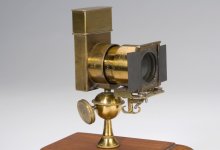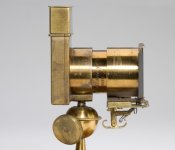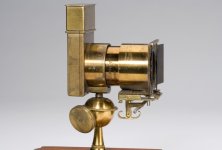It looks like our lack of proper research into the exposure and capability issues of the allegedly early days of photography plays into the mainstream BS narrative story line.
And while we all were tricked into thinking that those 1850s-1880s cameras were big, tripoded and required long stationary time due to exposure issues, they played with these ones below + 1. How long do you need to stay still with something like that?

Thompson’s Revolver Camera, 1862 Not all of the unusual cameras of this era focused on concealment, as shown by Thompson’s Revolver Camera. The ‘Revolver Photographique’, was patented in 1862 and made by the Parisian instrument maker A. Briois. The camera made four exposures on a circular glass plate, with the lens being held in the ‘barrel’ of the gun. This allowed the photographer to aim and steady the camera with one hand, using the other hand to operate the controls.


Fusil Photographique, 1882And then there's the great Etienne Marey's "Fusil Photographique", as it appeared in La Nature in 1882, which was an early and significant step in the development of cinematography, though again a highly problematic and time-invasive explanation out in public might escape the user:


Photo-Revolver de Poche , 1882The Photo-Revolver de Poche was invented by E. Enjalbert in Montpellier, France and constructed from 1882-1892. The camera was designed to look and operate like a handgun. The gun cylinder held ten 16 x 16mm dry plates. The image was taken just as if you were shooting a pistol, aim via a sight located on the top of the barrel and pull the trigger which instantaneously exposed the plate. The action of pulling the trigger back allowed the cylinder to be rotated for the next shot. The barrel housed a periscopic 70mm f/10 lens. The Photo-Revolver camera was nickel plated with wood handles just a like a pistol. Due to its inherent hostile appearance and possible misleading interpretation that the photographer was actually trying to kill someone instead of the harmless act of taking a photograph, this placed the photographer at times in jeopardy and so the Photo-Revolver did not fair well on editorial reviews or on the market. It has been reported that only 6 cameras are known to exist, with several replica's existing.
This ‘Rifle Camera’ was developed by Sands and Hunter in the 1880s. The longer, two-handed design meant it could take a steadier image than the Revolver Camera. It could also take 18 images before being reloaded, a significant increase from the four image limit of the Revolver Camera.

Stirn’s Secret Camera, 1886 Originally named ‘The Concealed Vest Camera’, patented separately by Robert D. Gray and C.P. Stirn in 1886, this circular metal camera was designed to be worn under the waistcoat with the lens protruding from a button hole. It was made in several models, with this model taking six 40mm diameter circular images on a 140mm circular plate.


Krugener’s Taschenbuch’ Patent Book Camera, 1888 Invented by German photographer Dr. Rudolf Krugner and produced in Germany by Haake and Albers from 1888, this model was the first of many successful book-shaped cameras. Several thousand were sold in various countries including France, Belgium and Britain. The camera took 24 plates, measuring 40mm squared, in an upper chamber. After exposure these were pushed down into a lower chamber by a metal rod for storage.

The above camera's including these pre-1900 ones do not even scratch the surface. Mainstream will probably say that they were worthless, but what else is new?
- I do not believe for a second that these cameras were simply "invented" out of nowhere but that is what this non-advertised story says. I can even guess that just like electric cars later on, these cameras were "not popular", or bad quality, or whatever else.
And while we all were tricked into thinking that those 1850s-1880s cameras were big, tripoded and required long stationary time due to exposure issues, they played with these ones below + 1. How long do you need to stay still with something like that?
Dagron Microphotographic Camera, c.1860
Dagron microphotographic camera made by René P P Dagron (1819-1900) in France, c. 1860. All-brass camera for multiple microphotographs; 25 lenses in 5x5 arrangement. Repeating back. On pillar and heavy iron base. Critical focusser.- John Benjamin Dancer (1812-1887) invented microphotographic process, but they required an expensive microscope to be viewed. Dagron invented a new, less expensive way of viewing microphotographs, by mounting them at the end of a small cylindrical lens. Dagron also designed this camera, which could take multiple microphotographs using 25 lenses in a 5 by 5 arrangement.
Thompson’s Revolver Camera, 1862
- There is a story of a similar, earlier model made by a Thomas Skaife, who, upon pointing his pistol-shaped camera at Queen Victoria during a procession, was promptly arrested!
Fusil Photographique, 1882
- E.J. Marey's photographic rifle of 1882 allowed to take a second, 12 shots at the 1/720° second.
Photo-Revolver de Poche , 1882
This ‘Rifle Camera’ was developed by Sands and Hunter in the 1880s. The longer, two-handed design meant it could take a steadier image than the Revolver Camera. It could also take 18 images before being reloaded, a significant increase from the four image limit of the Revolver Camera.
Stirn’s Secret Camera, 1886
Krugener’s Taschenbuch’ Patent Book Camera, 1888




